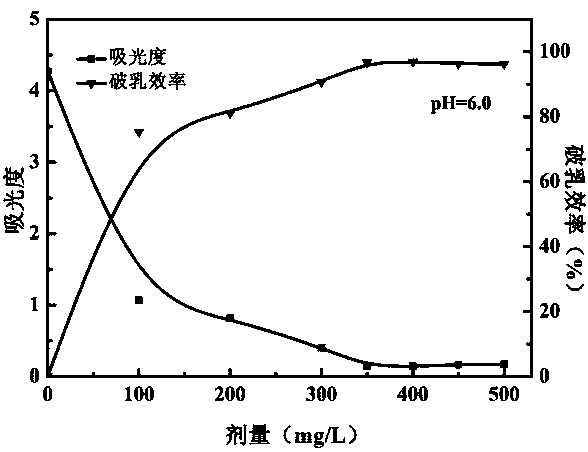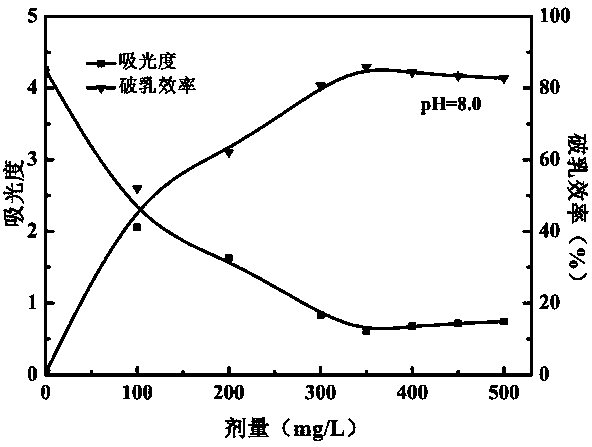Preparation method and application of magnetic inorganic clay-graphene composite demulsifying material
A graphene composite and graphene technology, applied in the field of inorganic materials, can solve the problems of inability to achieve efficient separation of oil-in-water emulsions, limitations in wide application, and large demulsification dose, and achieve excellent demulsification performance and high cycle stability. The effect of sex, efficient separation
- Summary
- Abstract
- Description
- Claims
- Application Information
AI Technical Summary
Problems solved by technology
Method used
Image
Examples
Embodiment 1
[0032] Example 1 Preparation of a magnetic inorganic clay-graphene composite demulsification material, comprising the following steps:
[0033] (1) Disperse graphene oxide in a polyethyleneimine aqueous solution with a concentration of 0.1 wt%, so that the concentration of graphene oxide in the polyethyleneimine aqueous solution is 0.1 wt%. After standing for 2 hours, it was stirred at 60 °C for 8 hours. After the reaction, suction filtration was performed to obtain product A; product A was successively washed with absolute ethanol and deionized water for several times, and freeze-dried at -40 °C for 24 hours to obtain the product graphene oxide. Complex.
[0034] (2) Disperse ferric chloride hexahydrate in 40 mL of ethylene glycol to make Fe in the mixed solution 3+ Then add 1.0 mol of sodium acetate and 1.5 g of polyethylene glycol to 1 L of the mixed solution in sequence, stir for 60 min, and then disperse 0.1 g of silane coupling agent-modified inorganic clay into the mix...
Embodiment 2
[0040] Example 2 Preparation of a magnetic inorganic clay-graphene composite demulsification material, comprising the following steps:
[0041] (1) Disperse graphene oxide in a polyethyleneimine aqueous solution with a concentration of 0.01 wt%, so that the concentration of graphene oxide in the polyethyleneimine aqueous solution is 0.01 wt%. After standing for 1 hour, it was stirred at 70 °C for 4 hours. After the reaction, suction filtration was performed to obtain product A; product A was successively washed with anhydrous ethanol and deionized water for several times, and freeze-dried at -30 °C for 36 hours to obtain the product graphene oxide. Complex.
[0042] (2) Disperse ferric chloride hexahydrate in 30 mL of ethylene glycol to make Fe in the mixed solution 3+ Then add 1.5 mol of sodium acetate and 1.0 g of polyethylene glycol in sequence to 1 L of the mixed solution, stir for 30 min, and then disperse 0.5 g of the inorganic clay modified by the silane coupling agent...
Embodiment 3
[0048] Example 3 Preparation of a magnetic inorganic clay-graphene composite demulsification material, comprising the following steps:
[0049] (1) Disperse graphene oxide in a polyethyleneimine aqueous solution with a concentration of 0.05wt%, so that the concentration of graphene oxide in the polyethyleneimine aqueous solution is 0.5wt%. After standing for 5 hours, it was stirred at 80 °C for 6 hours. After the reaction was completed, suction filtration was performed to obtain product A; the product A was successively washed with absolute ethanol and deionized water for several times, and freeze-dried at -20 °C for 48 hours to obtain product oxidation. Graphene composites.
[0050] (2) Disperse ferric chloride hexahydrate in 50 mL of ethylene glycol to make Fe in the mixed solution 3+ Then add 0.1mol sodium acetate and 0.5g polyethylene glycol in sequence to 1L mixture, stir for 40min, and then disperse 0.05g silane coupling agent-modified inorganic clay in the mixture, sti...
PUM
| Property | Measurement | Unit |
|---|---|---|
| Magnetic saturation | aaaaa | aaaaa |
Abstract
Description
Claims
Application Information
 Login to View More
Login to View More - R&D
- Intellectual Property
- Life Sciences
- Materials
- Tech Scout
- Unparalleled Data Quality
- Higher Quality Content
- 60% Fewer Hallucinations
Browse by: Latest US Patents, China's latest patents, Technical Efficacy Thesaurus, Application Domain, Technology Topic, Popular Technical Reports.
© 2025 PatSnap. All rights reserved.Legal|Privacy policy|Modern Slavery Act Transparency Statement|Sitemap|About US| Contact US: help@patsnap.com



